Trebuchet Roundup: Eight Online Plans Reviewed For Building Your Own

It’s autumn again. Such a wonderful time of year. Cider, hay rides, freshly bought school supplies. And launching things far through the air with catapults and trebuchets.
This year, instead of being a mere catapult observer, why not build your own? Building a basic trebuchet is really not that complex – it consists of a frame, a throwing arm, a counterweight, and a sling. The trickiest parts tend to be determining the sling release point, the bearings to get things rotating smoothly and deciding how big you want it to be. I’ve poured through various plans on the internet and have compiled a list of sites with notes to anyone that’s looking to make one for themselves.
Some of these are complete projects, while others are good for getting ideas on how to build your machine. Put it all together, add in some personal touches, and watch stuff go flying. Get busy!
==================
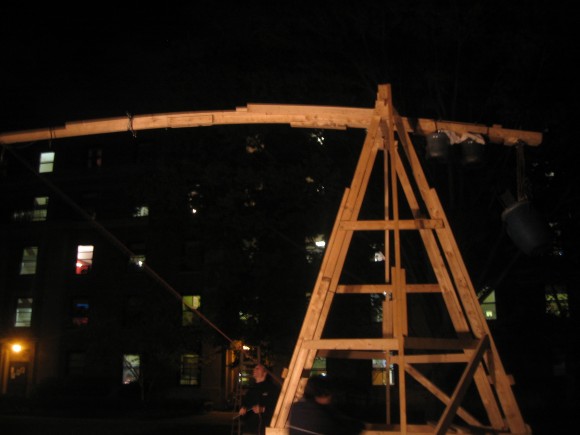
MIT college project that became much bigger than originally intended. Built almost entirely from 2×4’s, combined together for added strength and support as needed. Counterweights are inefficiently attached directly to the throwing arm, rather than using a separate container that articulates downward from the arm. Was able to throw an object of undisclosed weight/size (water balloons) 204′ with their best published throw, a distance that should be able to be improved greatly with small changes, owing to the large size of the machine. No blueprints or specific materials (aside from 2×4’s, which was their only material), but a decent selection of build photos. Good site to help get ideas for large builds. Project cost: about $200. (link)
==================
Trebuchet of the large variety (a work in progress)
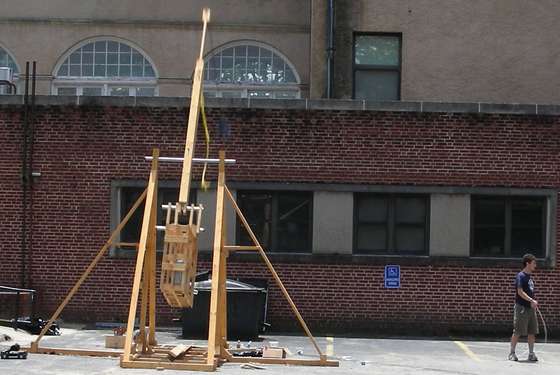
Instructable for a large-scale trebuchet with a hanging/articulating counterweight. Great writeup with a lot of information for each step, including detailed lengths for all the component pieces. Many Google Sketchup illustrations and downloads offered on it too. Sadly, the writeup stops before the author completes the project. Counterweights aren’t discussed; nor are the sling or trigger explanation. Still, one of the better set of notes on trebuchet plans online. Project cost: $315. (link)
==================
How To Build A Catapult / Trebuchet : Plans and Instructions
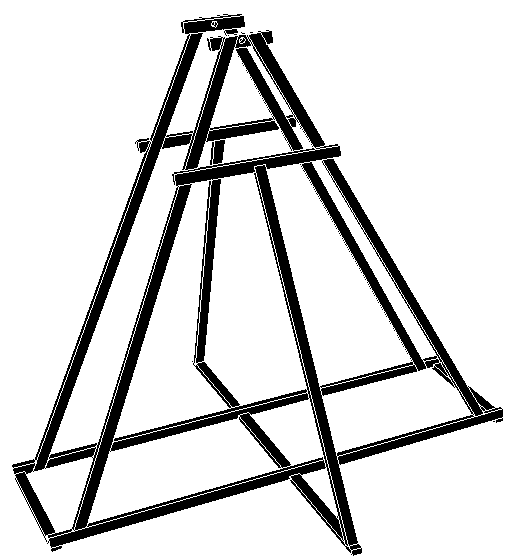
Full set of notes to build a medium trebuchet that has an approximately 3′ base. Information could be organized in a slightly easier to digest manner, but lots of specifics on the length of cuts needed and the manner of assembling the unit. A good deal of line diagrams are included, but photos would be more useful for certain sections. No costs included. (link)
==================

A 12″ tall trebuchet that can send a small ball 30′. Complete writeup with parts, dimensions, and a decent trigger system. Many good photos to help guide the build process. Primarily uses 1/4″ x 1/2″ bass wood. Can be assembled on your desktop. Project cost: $10. Build time: approximately 8 hours. (link)
==================
How to Build a Trebuchet (1 Meter Scale)

An general overview of a 1 meter tall trebuchet. Uses an ordinary bucket (5-gallon style) for the counterweight container. Their project claims to fire a croquet ball 30 meters (about 100 feet, not too shabby). No specific blueprints or material lists, but a good project to study to help gather the basics on what is involved in constructing one for yourself. Project cost: about $15. (link)
==================
Building A Catapult (Ludgar the Warwolf)

The most “artisan” trebuchets with build plans on the list – Ludgar the Warwolf is a gorgeous machine. Photos of the build are included on the site with general information about what is happening in each shot. However, no real details on the build process or specific materials is included. The site author also has two seige weapon books available for sale: The Art of the Catapult and Backyard Ballistics. No project costs listed. (link)
==================
Trebuchet Plans and Videos (How to Make a Trebuchet)
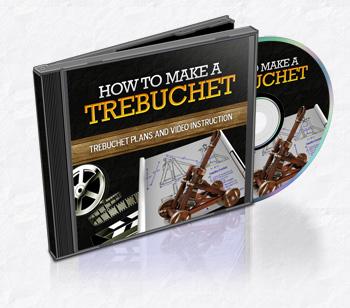
A set of plans for sale ($34.95, although free a “free” download is offered if you sign up for an outside product) that give you detailed building notes on building a 3′ trebuchet that is capable of launching over 100′. The blog for the site has a lot of information on terminology and recommended ratios (throwing arm vs. counter arm length, etc). Very, very useful for fine-tuning the efficiency of your hurler as you get serious about launching stuff. Project costs: about $100. (link)
==================
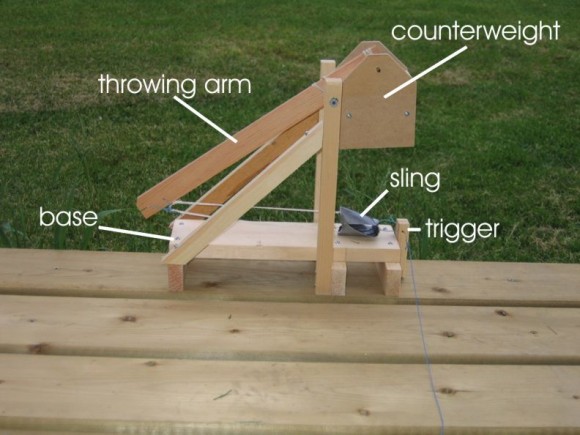
Tabletop sized trebuchet, fairly rudimentary in design. However, the website has a very complete set of notes on how to prepare and assemble all the parts, with many cleanly labeled photos (if only all DIY sites could be so meticulous and clear). In addition to the build notes, the site also put together a 5 minute instructional video that explains the science and physics of trebuchets. A great companion piece to any classroom learning/building situation. No project costs listed, but won’t cost more than a few dollars. (link)
==================
Some last notes:
– On smaller trebuchets, the firing pin/trigger mechanism can be fairly light and easy. However, larger trebuchets with massive counterweights get into the trouble of binding up most simple triggers. Medieval machines are still researched for what they used to release their weight. Many current trebuchets use a quick-release system called the SeaCatch. These are elegant, high quality units made in a variety of sizes. They’re expensive – I would have loved to have one for Catch It Keep It, but they were outside our budget. Smallest units cost $500. The large ones used by tugboats are $50,000. They’re awesome.
– More good info on trebuchets (and kits to buy) can be found here: trebuchet.com
– Interesting observation: none of the plans listed have wheels as part of the unit. Adding wheels onto trebuchets served two purposes. It allowed them to be rolled to battle easily, and it allowed them to increase their efficiency by letting the counterweight to fall in a more directly vertical path. As the counterweight drops, the wheels move the unit to compensate for the rotational energy it automatically has by being on a pivot. Something to consider adding as you build your own.
– Amazon has a number of trebuchet kits that allow you the satisfaction of building your own machine, but take out some of the guesswork of sizing and tuning all of the pieces. I like the looks of this miniature desktop unit.
